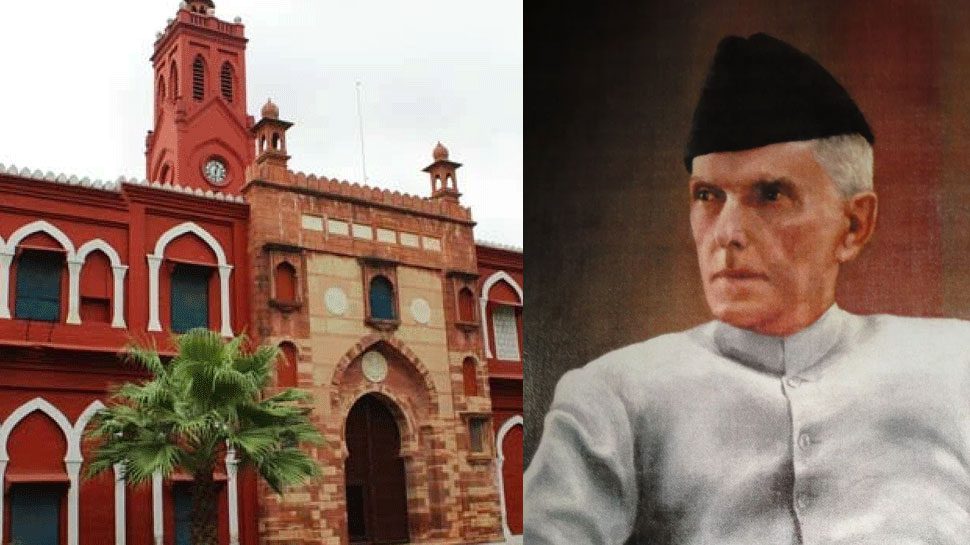Reading Time: 3 minutes
The young men of AMU are examples that Jinnah’s hare-brained scheme may not have been given a clean burial in India. Much is made of the Indian Muslim being different from the Pakistani Muslim; that he stuck on in India after Partition because he never cottoned to Jinnah’s two-nation theory. Now, 70 years after Partition, there is this sneaking feeling that maybe not, after all, it was all a hoax, a Trojan horse! Here’s an analysis, for Different Truths.
Young Indian men are squabbling outside the Aligarh Muslim University campus over a portrait of Mohammad Ali Jinnah on the wall of the AMU Students’ Union office. It has so far not become one ‘helluva fight’. But it will if the portrait, removed from the wall and sent for ‘dusting’ the day after it became grist for the mill, returns to its place on the AMU Wall.
AMU justifies Jinnah on its wall because “he was one of the founding members of AMU”, which is at best a red herring and at worst an outright lie. There are no records of Jinnah ever turning up in his skinny-frame to any of the huddles that took the AMU idea forward. AMU’s most talked about founder Sir Syed Ahmed Khan would testify to that if he was around, which he isn’t.
The AMU Student’s Union (AMUSU) calls Jinnah a ‘Hero’. And everybody’s entitled to one ‘hero’. But AMUSU doesn’t own AMU. And Jinnah is not a hero to India. Not after his infamous statement, ‘We shall have India-divided or we shall have India-destroyed” that set the tone for the Partition of India. That is besides all secret parleys between Jinnah and the scheming British.
Jinnah was the one and only architect of the Partition of India, which killed millions and set in motion an unplanned two-way exodus of people, the likes of which the world has never seen to this day. Pakistan was conceived on Jinnah’s belief that the Hindu and the Muslim cannot live together unless the Muslim gets the right to rule over the Hindu.
Pakistan came to be because of that pig-headedness, which was his leitmotif, and on the untold misery, he unfolded on the subcontinent. He never expressed remorse for the deaths and rapes and rapine that Partition brought. The two-nation theory he championed was as emaciated an idea as the frame on which his skin hung. But, as unlikely as it may sound, the idea has survived – not just in Pakistan but in India, too.
The young men of AMU are examples that Jinnah’s hare-brained scheme may not have been given a clean burial in India. Much is made of the Indian Muslim being different from the Pakistani Muslim; that he stuck on in India after Partition because he never cottoned to Jinnah’s two-nation theory. Now, 70 years after Partition, there is this sneaking feeling that maybe not, after all, it was all a hoax, a Trojan horse!
Some grand schemes take centuries to fructify and this could be one of them. Pakistani fanatics-breeders off and on talk of Jinnah’s two-nation theory, say that it is ‘unfinished business’ left for the future to finish. Gazwa-e-Hind is what they name it, the unfinished business. Oh! Yes, such unsecular thoughts are not supposed to be harboured. Not in a secular country. They are “haraam”, not kosher, a-dharma, illicit products made in the devil’s workshop. And India is, by hook or crook, secular. So God save the one-nation notion!
But should that mean ‘give Muhammad Ali Jinnah a clean-chit’? A Washington Post article on the eve of the 70th anniversary of Partition contained this para: “Bungalows and mansions were burned and looted, women were raped; children were killed in front of their siblings. Trains carrying refugees between the two new nations arrived full of corpses; their passengers had been killed by mobs en route. These were called “blood trains”: All too often they crossed the border in funereal silence, blood seeping from under their carriage doors.”
That is the kind of untold horror Jinnah visited on the subcontinent. The whisky-loving Qaid-e-Azam of Pakistan with a liking for pork delicacies left his earthly abode a year after the bloody partition of India but before he left for good he left behind problems for India that are off-shoots of the sapling he planted. Whether it is the Kashmir problem or cross-border terrorism, all are Jinnah’s doing. If comparisons to Hitler are far-fetched, Jinnah was no less a paranoid xenophobic than the Nazi.
Worst of all, Jinnah’s two-nation mentality has found acceptance in the Hindu, the metamorphosis as much a horror as that of the cockroach in Kafka’s head. The Jinnah mind-set that some people talk of must be verbally-whipped and mentally scraped. His portrait in AMU must be dusted, packaged and handed over to the Pakistani Rangers at the Wagah border – after another macho display of ‘who kicks higher, you or me?’
Sushil Kutty
©IPA Service
Photos from the Internet















